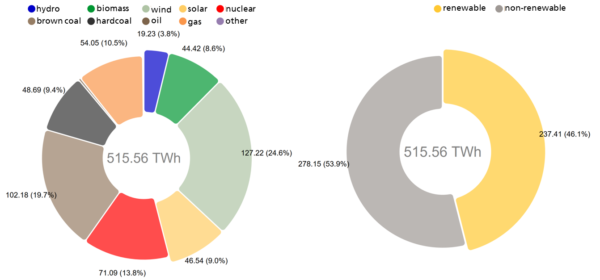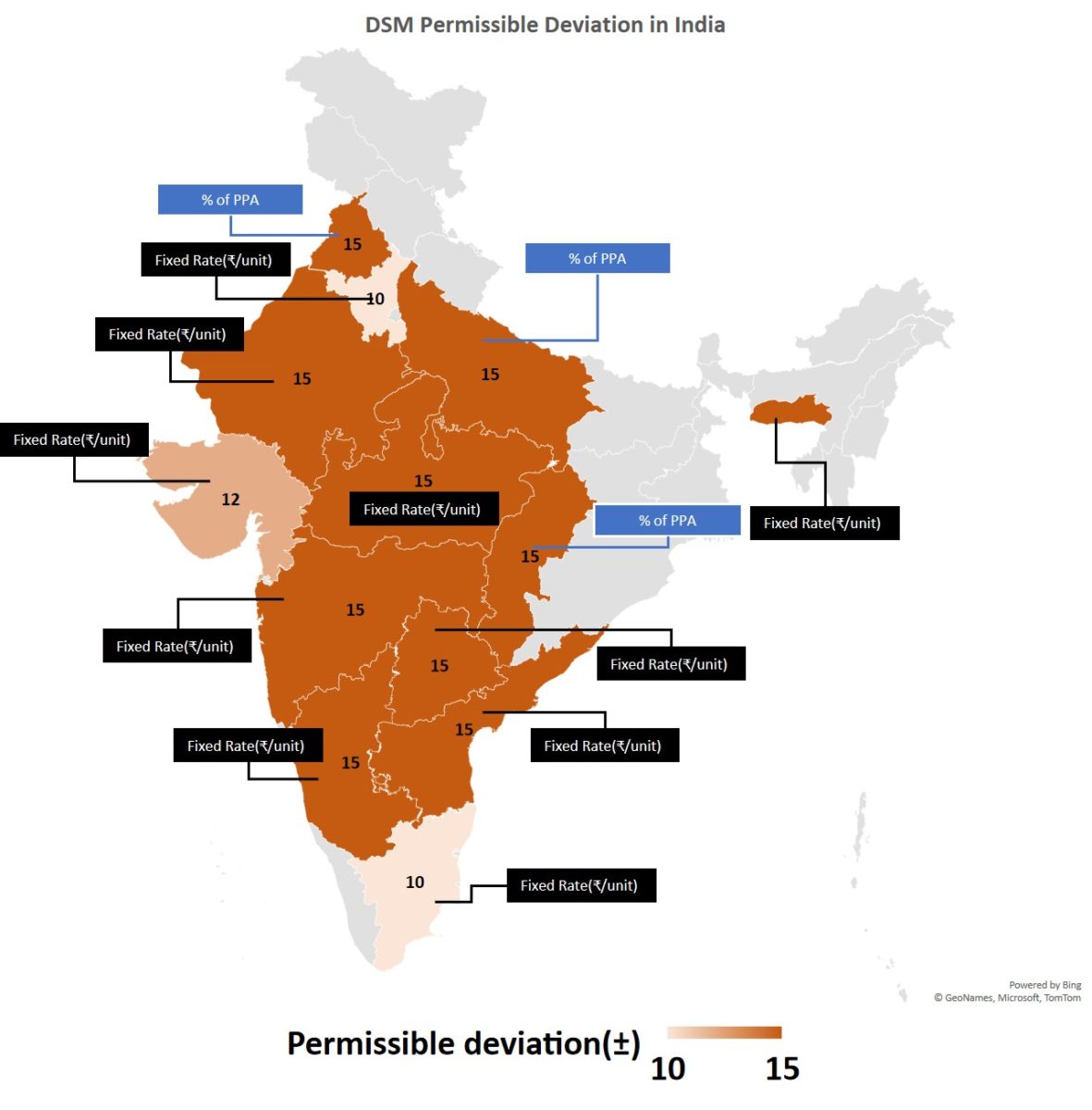The world, especially India, has come a long way in the renewable energy proliferation journey. India has matured from the nascent stage to the growth stage, with around 35,000 MW of solar power generation capacity already installed in the country.
Like with any other technology, solar-related policies and regulations integral to its technology and operations are evolving with the period. One such regulation that is being talked of late is the Deviation Settlement Mechanism (DSM).
To accommodate the growing penetration of renewable energy and related infirm generation, the Central Electricity Regulatory Commission (CERC) published for the first time DSM regulations specifically for renewable energy in 2014.
Consequently, the Forum Of Regulators (FOR) published model DSM regulations to define standards for state regulatory bodies. As of today, 14 Indian states have published RE specific DSM regulations.
This article aims to explain the status of DSM regulations in India, the need for uniformity across the country and how we can ‘do something mindful’ (also DSM) while learning from our European, American and Australian counterparts.
DSM regulations in India
Under the current DSM regulations, an acceptable deviation band has been defined where any deviation will not be penalized up to some percentage of the scheduled energy (MWh) and a penalty is levied for each time block where the deviation is higher than the defined band limit.
The permissible DSM deviations (±) in different states are illustrated below.

While many states levy deviation charges as a fixed rate Rs/unit (kWh), others like Uttar Pradesh, Punjab and Chhattisgarh levy these charges as a percentage of the PPA value signed.
The State Electricity Regulatory Commissions (SERCs) of Karnataka, Andhra Pradesh, Rajasthan, Madhya Pradesh, Telangana, Maharashtra, Meghalaya, Uttar Pradesh, Punjab and Jharkhand have set 15% as the permissible limit and after that a fixed rate penalty for three slabs.
Haryana Electricity Regulatory Commission (HERC) has set permissible band limit of 10%, beyond which fixed charges shall be applicable at the same rate as applicable under these SERCs.
On the other hand, Gujarat Electricity Regulatory Commission (GERC) has a more stringent band of 7% for solar and three different slabs and penalties for each slab.
Chhattisgarh State Electricity Regulatory Commission (CSERC) and Uttar Pradesh Electricity Regulatory Commission (UPERC) published DSM Regulation with an error band of 15% and PPA-linked charges similar to CERC.
TNERC, on the other hand, came up with a permissible band limit of 10%, beyond which charges shall be applicable as Rs 0.25/kWh, Rs 0.5/kWh and 1.0/kWh for absolute (Abs) error >10-20%, >20-30% and >20-30%, respectively.
Presently, only Karnataka and Andhra Pradesh have allowed aggregation of scheduling at the level of Qualified Coordinating Agency (QCA), which means the penalty is imposed on the aggregated quantity of energy generation under the QCA.
However, in other states, solar generators are being penalized for deviation at project level as well as for the deviation impact at the state level. This specific element of the regulations has material implications for long-term viability of renewable energy projects in India, increasing the burden on project developers. Hence, it is critical that the relevance of ‘Aggregation at pooling substation (PSS) level only’ is evaluated carefully and necessary amendments in regulations are made.
Key challenges in current regulations
Additional penalty burden due to no aggregation. In states without aggregation, apart from the deviation at the state level the deviations are calculated at PSS level. This is passed through solar projects, resulting in developers’ penalties as high as Rs0.06 – Rs0.08 per kWh at the project level.
Restriction to number of revisions compared to thermal. Solar generators are only allowed nine revisions, whereas there is no such limit for conventional generators. Developers become more liable in case of any sudden change in the environment like cloud cover or rain which is beyond their control.
Only penalty, no incentive: While conventional generators enjoy both penalty and incentive for scheduling, RE developers are only being penalized.
Same accuracy bands for all seasons. Accuracy bands are the same for all seasons by ignoring monsoons, where chances of falling out of permissible band limits are higher.
How it works in Germany
Germany is one of the world leaders in the energy transition, with around 46% of its total energy mix coming from renewable energy. In Germany, all electricity generators, including RE generators, and consumers are assigned to a balancing group, and there are multiple balancing groups within each Transmission System Operator (TSO).
The balancing groups are not in-charge of physically balancing the system (i.e., it is not a control area). Instead, they are entities that aggregate the schedules from multiple generators and consumers and schedule resources accordingly.
There is a financial settlement between the TSOs and balancing groups, depending on the actual deviations from their schedule. This creates an incentive for balancing groups to balance resources internally to avoid being exposed to the balancing market operated by the TSO.
The balancing groups are essentially aggregators like QCAs in India. The error in schedules by RE generators under a balancing group is minimized due to averaging individual errors by each RE generator. The operators of electricity supply grids are obliged to maintain a balancing group, which exclusively comprises energy that is remunerated with a feed-in tariff from RE suppliers in the grid area for transmission to the balancing group of the transmission grid operators.
On 1 April 2020, 1946 balancing groups were managed by a total of 686 contract partners in the grid area of 50Hertz Transmission GmbH.

What’s the solution?
More resource assessment stations. In a country like India, where Solar Radiation Resource Assessment Stations are only at a few developed places, it is not possible to achieve the accuracy demanded by current forecasting regulations.
Although a significant number of stations are installed under the ambit of Solar Radiation Resource Assessment (SRRA) at 115 locations, the country still needs to intensify efforts in creating an infrastructure for radiation assessment and measurement. This will help seamless access to radiation data of a wide range of locations while improving the existing numerical weather models’ performance with increased data sets.
Penalize, but incentivize. Contrary to the Indian context, where there is only a penalty mechanism for deviation against schedule by QCAs, the balancing groups in Germany also have an incentive mechanism to support the grid. A similar incentive mechanism should be provided to the QCAs for assisting in grid management. This would ensure motivated effort by QCAs to ensure seamless grid management.
Rationalize the error bands and penalty mechanism. There should be both an innovative and rational way of calculating the penalty and admissible deviation season-wise.
Integration. In developed countries, balancing groups (QCAs) comprise RE suppliers, providing balancing power, to enable balancing of transmission grid by the TSOs who manage regional transmission grids. This model should also be replicated in India. Similarly, QCAs should be provided with greater coverage, i.e., up to regional transmission grid level, to derive higher benefit from schedule–actual deviation diversification and also ensure higher grid reliability.
Indian Prime Minister’s vision has always been to minimize the government and maximize governance. India is now a key proponent of ‘One world, One sun and One grid.’ While our plans are ambitious yet pragmatic on the global scale, it would be good to rationalize and ensure uniformity of regulations across the country—One Nation, One Sun and One DSM—for seamless RE integration.
The views and opinions expressed in this article are the author’s own, and do not necessarily reflect those held by pv magazine.
This content is protected by copyright and may not be reused. If you want to cooperate with us and would like to reuse some of our content, please contact: editors@pv-magazine.com.








By submitting this form you agree to pv magazine using your data for the purposes of publishing your comment.
Your personal data will only be disclosed or otherwise transmitted to third parties for the purposes of spam filtering or if this is necessary for technical maintenance of the website. Any other transfer to third parties will not take place unless this is justified on the basis of applicable data protection regulations or if pv magazine is legally obliged to do so.
You may revoke this consent at any time with effect for the future, in which case your personal data will be deleted immediately. Otherwise, your data will be deleted if pv magazine has processed your request or the purpose of data storage is fulfilled.
Further information on data privacy can be found in our Data Protection Policy.